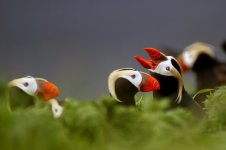Before providing the examples, I simlely introduce the background of researches of sexual selection.
Darwin advanced sexual selection to explain the colorful appearance of male birds in terms of the taste of female choice according their beauty preferences(10). Wallace objected strongly, saying that this is adding an additional principle of beauty selection on top of natural selection, without explaining how female taste for beauty comes from (11, 12). Wallace used camouflage and signaling to explain colorful plumage in birds, used good sense to explain female sexual selection (selecting good characteristics in males), while denying the selection of male appearance by the taste for beauty of the female birds (13, Chapter 7). Later, Fisher advanced a theory in sexual selection (14) called arm-race theory to reconcile the contradiction between Darwin and Wallace.
Wallace explained the plumage of female birds and dancing in many bird species better, while Fisher explained the big tails in some bird species better. There are also other theories (15) each with some advantages. However, many cases (e.g. the ocelli in the plumage of Peacocks, the yellow tail of Mandarin Ducks, the special patterns in the faces of Baikal Teals, Macaws, and King Vultures) are difficult to be explained by current theories.
We wish to advance Demand-raising-beauty theory (8) to explain the particular patterns, not only in peacock but also in many other species. Firstly, Bird’s demand for food or environment raised their tastes for beauty so that they could survive better, later the female taste selected the male appearances. For example, humming birds’ demand for flowers raised their taste for beauty on flowers, later, the female selected the male appearances so that male humming birds display flower patterns on necks or heads. These traits may pass to their sons, or also to daughters.
References:
8. C. Lu, Trying to resolve the problem left by Darwin about fragrance ,sweetness and beauty, Information from Nature, in Chinese, 2, 25-27 (1987)
10. C. Darwin, The Descent of Man, and Selection in Relation to Sex, London: John Murray (1871).
11. A. R. Wallace , Review of Darwin’s Descent of Man, The Academy 2, 177-183 (1871).
12. A. R. Wallace, Notes on natural selection, Natural Science 1, 749-740 (1892)
13. H. Cronin, The Ant and the Peacock, Cambridge University Press (1991).
14. R. A. Fisher, The evolution of sexual preference, Eugenics, Review, October; 7(3): 184–192 (1915).










